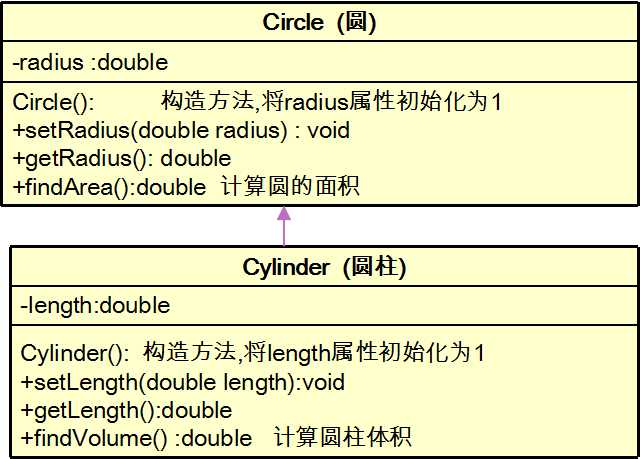标签:根据 属性 date protected ... 重新定义 volume person ext
Java类的继承
为描述和处理个人信息,定义类Person:
public class Person {
public String name;
public inat age;
public Date birthDate;
public String getInfo()
{...}
}
为描述和处理学生信息,定义类Student:
public class Student {
public String name;
public int age;
public Date birthDate;
public String school;
public String getInfo()
{...}
}
通过继承,简化Student类的定义:
public class Person {
public String name;
public int age;
public Date birthDate;
public String getInfo() {...}
}
public class Student extends Person{
public String school;
}
Student类继承了父类Person的所有属性和方法,并增加了一个属性school。Person中的属性和方法,Student都可以利用。
类继承语法规则:
< 修饰符> class < 子类名称> [extends < 父类>]
{
<属性和方法的声明>
}
Java只支持单继承,不允许多重继承
一个子类只能有一个父类,一个父类可以派生出多个子类
子类继承了父类,就继承了父类的方法和属性。
在子类中,可以使用父类中定义的方法和属性,也可以创建新的数据和方法。
在Java 中,继承的关键字用的是“extends”,即子类不是父类的子集,而是对父类的“扩展”。
关于继承的规则:
子类不能继承父类中私有的(private)的成员变量和方法。
例子:
public class Person { public String name; public int age; public Date birth; public String getInfo(){ return "name: " + name + ", " + "age: " + age + ", " + "birth: " + birth; } }
public class Student extends Person{ public String school; public void print() { //System.out.println(this.lover); } }
public class TestPerson { public static void main(String[] args) { Student student = new Student(); student.name = "Jerry"; student.birth = new Date(); student.age = 1; student.school = "atguigu"; // student.lover = ""; System.out.println(student.getInfo()); Person person = new Person(); person.age = 1; person.birth = new Date(); person.name = "Tom"; System.out.println(person.getInfo()); } }
练习
1、(1)定义一个ManKind类,包括
成员变量 int sex 和 int salary;
方法 void manOrWorman():根据sex的值显示“man”(sex==1)或者“women”(sex==0);
方法 void employeed():根据salary的值显示“no job”(salary==0)或者“ job”(salary!=0)。
1 /** 2 * 定义一个ManKind类,包括 3 * 成员变量 int sex 和 int salary; 4 * 方法 void manOrWorman():根据sex的值显示“man”(sex==1)或者“women”(sex==0); 5 * 方法 void employeed():根据salary的值显示“no job”(salary==0)或者“ job”(salary!=0)。 6 */ 7 public class ManKind { 8 9 int sex; 10 int salary; 11 12 public void manOrWoman() { 13 if(sex == 0){ 14 System.out.println("woman"); 15 }else if(sex == 1){ 16 System.out.println("man"); 17 } 18 } 19 20 public void employeed() { 21 if(salary != 0){ 22 System.out.println("job"); 23 }else{ 24 System.out.println("no job"); 25 } 26 } 27 }
(2)定义类Kids1继承ManKind,并包括
成员变量 int yearsOld;
方法 printAge() 打印 yearsOld 的值。
(3)在Kids1类的main方法中实例化Kids1的对象 someKid,用该对象访问其父类的成员变量及方法。
1 /** 2 * 定义类 Kids1 继承ManKind,并包括 3 * 成员变量 int yearsOld; 4 * 方法 printAge() 打印 yearsOld 的值。 5 * 6 * 在Kids1中重新定义employed() 方法,覆盖父类ManKind中定义的employed()方法, 7 * 输出“Kids should study and no job.” 8 */ 9 public class Kids1 extends ManKind{ 10 11 int yearsOld; 12 13 void printAge(){ 14 System.out.println("yearsOld: " + yearsOld); 15 } 16 17 //修改练习3中定义的类Kids1中employed()方法,在该方法中调用父类ManKind的employed()方法, 18 //然后再输出“but Kids should study and no job.” 19 public void employeed() { 20 super.employeed(); 21 System.out.println("Kids should study and no job."); 22 } 23 24 //在Kids1类的main方法中实例化Kids1的对象 someKid,用该对象访问其父类的成员变量及方法。 25 public static void main(String[] args) { 26 Kids1 someKid = new Kids1(); 27 someKid.sex = 1; 28 someKid.salary = 5000; 29 someKid.yearsOld = 25; 30 31 someKid.manOrWoman(); 32 someKid.employeed(); 33 someKid.printAge(); 34 } 35 }
2、根据下图实现类。在TestCylinder类中创建Cylinder类的对象,设置圆柱的底面半径和高,并输出圆柱的体积。

1 public class Circle { 2 3 protected double radius; 4 5 public Circle(double radius) { 6 this.radius = radius; 7 } 8 9 public double getRadius() { 10 return radius; 11 } 12 13 public void setRadius(double radius) { 14 this.radius = radius; 15 } 16 17 public double findArea(){ 18 return 3.14 * radius * radius; 19 } 20 }
1 public class Cylinder extends Circle{ 2 3 private double length; 4 5 public Cylinder() { 6 this.length = 1; 7 } 8 9 public double getLength() { 10 return length; 11 } 12 13 public void setLength(double length) { 14 this.length = length; 15 } 16 17 /** 18 * 返回圆柱的体积 19 * @return 20 */ 21 public double findVolume(){ 22 return super.findArea() * length; 23 } 24 25 /** 26 * 返回圆柱的表面积 27 */ 28 @Override 29 public double findArea() { 30 return super.findArea() * 2 + 2 * 3.14 * radius * length; 31 } 32 }
1 public class TestCylinder { 2 public static void main(String[] args) { 3 4 Cylinder cylinder = new Cylinder(); 5 6 cylinder.setLength(2); 7 8 //返回表面积 9 System.out.println(cylinder.findArea()); 10 //返回体积 11 System.out.println(cylinder.findVolume()); 12 } 13 }
标签:根据 属性 date protected ... 重新定义 volume person ext
原文地址:http://www.cnblogs.com/justdoitba/p/7223311.html